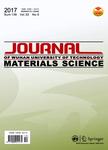Radioactive Element Distribution Characteristics of Red Mud based Field Road Cement before and after Hydration
Radioactive Element Distribution Characteristics of Red Mud based Field Road Cement before and after Hydration作者机构:School of Civil Engineering and Communication North China University of Water Resources and Electric Power Zhengzhou 450001 China College of Materials Science and Engineering Zhengzhou University Zhengzhou 450001 China College of Materials Science and Engineering Tianjinchengjian University Tianjin 300384 China
出 版 物:《Journal of Wuhan University of Technology(Materials Science)》 (武汉理工大学学报(材料科学英文版))
年 卷 期:2018年第33卷第2期
页 面:452-458页
核心收录:
学科分类:08[工学] 0805[工学-材料科学与工程(可授工学、理学学位)] 080502[工学-材料学]
基 金:Funded by the National Natural Science Foundation of China(No.51172155)
主 题:red mud distribution radioactivity specific activity cement hydration
摘 要:Red mud was firstly used as a raw material in sintering field road cement. Then, the radioactive element distribution characteristics of red mud based field road cement(RFC) before and after hydration were comparatively investigated. The experimental results indicated that the specific activity of ^(226)Ra and ^(232)Th increased after sintering process from raw material to clinker, as a result of concentrating effect on ^(226)Ra and ^(232)Th during sintering process, but the specific activity of ^(40)K decreased after sintering process as a result of volatilization effect. Radionuclide ^(226)Ra mainly distributed in RFC silicate phases(C_xS), ^(232)Th distributed more in RFC interstitial phases than RFC silicate phases(C_xS), ^(40)K mainly distributed in RFC interstitial phases. With increasing hydration ages of RFC pastes, the specific activity of ^(226)Ra kept increasing, ^(232)Th remained consistency all the same and ^(40)K declined. The radioactivity of RFC was in the recommended safe limit of Chinese National Standards GB6566-2010 during its preparation and application process.



